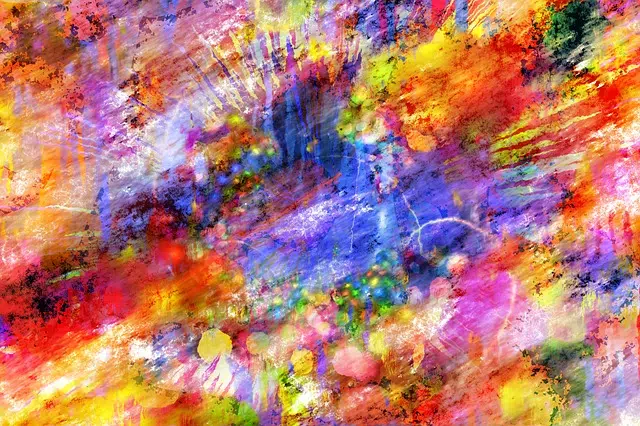
Abstract art emerged as a response to realism.
The concept of abstract derives from the Latin term abstractus and refers to a certain quality where the subject is excluded . When the word is applied to the artistic field or to an artist , it describes the intention not to represent specific beings or objects ; On the other hand, only elements of shape, color, structure or proportion, for example, are considered.
Abstract art is, then, a style that focuses on formal, structural and chromatic details and deepens them through the accentuation of their value and expressive power. The abstract artist does not imitate models nor work according to natural inspiration .
Origins of abstract art
Its origin dates back to approximately 1910 , as a reaction to realism and the appearance of photography . In this way, abstract art does not consider figurative representation to be justified and, therefore, replaces it with an autonomous visual language that has its own meanings.
In painting, the abstract style completely distances itself from the structures proposed by realism where every work was a representation of something specific (landscapes, houses, flowers, living beings) and, using a language that has no form or specific codes and where the Freedom is reflected above all in the use of chromaticism, it represents entities that do not have their model in reality. There are as many abstract universes as painters have devoted themselves to this type of artistic representation .
We owe the beginning of abstract painting to Wasily Kandinsky , a Russian artist from the beginning of the last century who claimed that in painting a round spot of colors could represent a human body since art is a consequence no longer of what we see but of how we see it . The line, the plane and the space mean nothing, until they acquire a certain meaning from a discharge of energy that occurs within the artist's mind.
The current in sculpture
If we look at abstract sculpture we will find that throughout the 20th century and this one, many plastic artists have emerged who were inclined to develop an abstract style.
Among them we can mention Hans (Jean) Arp who was also a painter and took his abstract notions of painting to three dimensions, creating organic forms that reflected his vision of reality, as the result of an organic body. He was the one who developed an iconography that was called biomorphic sculpture to which many abstract plastic artists devoted themselves and continue to do so.
abstract expressionism
When the Second World War ended, an artistic movement emerged that in a short time had a large number of followers, abstract expressionism . Its bases were in surrealism (a booming movement in the prewar) and it was based on the combination of different techniques in the same work. An important style that becomes very popular in this movement is collage , which uses mixtures of different materials or elements, such as plaster and sand, to give a flat fabric a certain three-dimensional roughness characteristic of sculpture. Among the fundamental protagonists of abstract expressionism were Jackson Pollock and Willem de Kooning .
One of the fundamental representatives of Spanish abstract expressionism is José Manuel Ciria , who has held exhibitions in important centers such as the Cervantes Institute of Chicago, the Valencian Institute of Modern Art, and in galleries in Paris, the United States, England, Argentina and Portugal.

Love is an abstract noun.
The concept in grammar
In the field of grammar there is the term abstract noun . To understand this concept, it is necessary to first clarify the noun.
A noun is one of the fundamental elements in a sentence , which does not need the appearance of another to make sense and exist within it (house, child, dogs, Elena). The same does not happen with adjectives that are always attached to a noun that they modify in one way or another (cute, friendly, playful, blonde). Nouns can be divided into several types, some of them opposite to each other. This is the case with the classification of concrete and abstract nouns.
A noun is abstract when it is used to mention an object that can only be appreciated or believed using intelligence , unlike the nouns that are part of the concrete group , where objects appear that are perceived thanks to the senses.
Nouns and abstract verbs
According to the philosopher José Ortega y Gasset, we can understand an abstract noun as that word that names an object that is not independent , that is, that always needs another element to rely on in order to be. This means that these nouns, since they do not refer to a specific element, refer to objects that cannot be perceived with the senses, but rather imagined.
Some examples of abstract nouns are love and happiness ; so are certain political concepts such as power, dictatorship and democracy and so are the seasons of the year, science and religion.
On the other hand, a verb is abstract when it is constituted by “ser” , a copulative verb that is given the function of an attribute and lacks a specific meaning. In the statement “I am a human being” , “I am” is highlighted with an abstract verb.
The notion in mathematics and philosophy
In the field of mathematics there is the concept of abstract algebra that brings together the sector of mathematics that works with algebraic schemes (ring, group, body or vector space). This study arose from the need to obtain greater accuracy in mathematical definitions.
It is also worth mentioning within this definition the notion of abstract thought , which refers to the interior worlds created by human beings to understand existence. It consists of the way in which the human being grouped the ideas, concepts, images and objects that allow him to contain knowledge .
